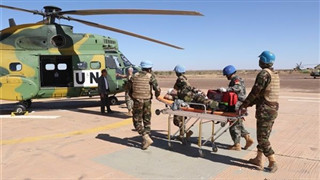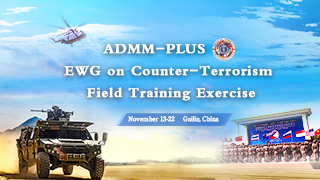
By Liang Fang
After the US killed Gen. Qassem Suleimani, a senior commander of the Iranian Islamic Revolutionary Guard Corps (IRGC), by shooting missiles from drones, Iran began to take revenge on January 8 by launching two waves of missile attacks to the US-manned military bases in Iraq. After that, Iran had announced it does not seek escalation of war. How will the US react to Iran’s revenge has been the focus of the world.
This bout has resulted in strategic impacts on the Middle East and subversive changes in the patterns of warfare, which worth paying great attention.
The US carried out the assassination for three strategic purposes.
First, by doing so, the US intends to ensure a credible military deterrent in the Middle East. The series of back and fill has caused US all its credibility, the NATO summit was fruitless, members are still arguing about military expenses for American stationed troops, and the escort coalition is falling apart. On the contrary, Russia, Iran and Syria made great contributions to the anti-terror campaign by fighting side by side with each other, with growing influence in the Middle East. Washington decided to kill the Iranian general at this moment to tell the world who the boss is in the Middle East.
Second, the move is motivated by anxiety over major-power competition. Nowadays, the US is relatively weak, while emerging countries are rapidly rising. It decided to create a crisis for Iran in order to cement its control over and influence in the Middle East, squeeze the sphere of influence and development space of the Russians’ and Iranians’, and prevent comprehensive integration and cooperation between the Asian and European continents.
Third, the move is to lower the cost of warfare. The US military has carried out much more precise overseas operations on specific targets ever since 2008, and studied and implemented the “hybrid warfare”, of which the targeted elimination this time is just one of many approaches, along with political pressuring, economic sanction, diplomatic isolation, allied opposition and other means it had adopted against Iran previously. In this way, the US hoped to realize the aim that “to discover is to destroy and to fight is to victory”, which in a way is also a low-cost attempt at Iran’s bottom line.
After America’s brutal assassination of Suleimani, Iran backed out of the nuclear deal in fury and has taken revenge, which will probably plunge the Middle East into a new cycle of unrest.
First of all, targeted elimination may add fuel to the flame of global terrorist activities. Washington made a strategic mistake of killing a foreign military leader in the name of “counter terrorism”. There is no legal ground for it to define “targeted elimination” as a kind of “overseas military operation” as that is far beyond the scope of force that can be used for self-defense as stated in the UN Charter. What it did sent the message that the US can define an enemy, wage a war and wipe out anyone as it wishes, which is extremely dangerous.
Moreover, the spread of the targeted elimination approach by terrorist organizations will increase global terrorist and violent activities by a large margin. The “Pandora’s box” opened by America will throw the Middle East security situation into an abyss and make things tough for the US itself in the region. Two or more parties will enter the vicious cycle of mutual revenge.
Second, patterns of warfare see subversive changes. Future warfare will be IT-based, unmanned and intelligent, and the elements of victory will be changed profoundly. Although Washington has absolute edges over Teheran, the latter, however, is able to fight back either by attacking America’s Middle East allies such as Israel and UAE or fighting a proxy war by coordinating multiple private armed forces in the region, thus avoiding a head-on war with the US while achieving its goals.
Besides, Iran can use unmanned aerial vehicles (UAVs) and missiles to attack American facilities in the Middle East and its cargo ships crossing the Strait of Hormuz, or use Internet technologies to sabotage America’s government, military and financial systems, or launch an international offensive of public opinions against the US. Therefore, in the game between Washington and Teheran, there will be both traditional battles and “combination punches” in multiple fields
Third, the chaos in the Middle East will last long. The recent movements by the US reflected its re-evaluation of the Middle East, where peace is anything but certain at the moment. Feeling a sense of crisis there, Washington will take actions it was unwilling to take or it didn’t take very often in the past, adding new uncertainties to the current chaos.
Considering the scope and intensity of its vengeful operations, Iran doesn’t want to escalate the conflict with the US, so it has exercised restraint when throwing back punches, with the ultimate goal of US lifting its economic sanctions. Whether Washington will take a tougher stance will depend on whether Teheran’s vengeance will escalate and cause casualties to Americans. Either way their game in the Middle East won’t end any time soon.
No matter what military means America will use, it cannot stop the general trend of win-win cooperation and common development of the current time. Instead of getting it what it wants, resorting to force will only lead it to a dead end of being isolated without any support from anyone.
(The author Liang Fang is a professor with the College of National Security under the National Defence University of the Chinese People's Liberation Army)











